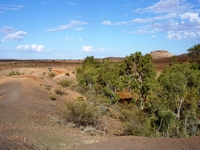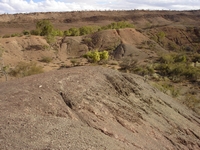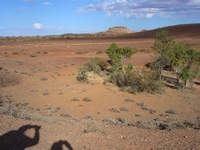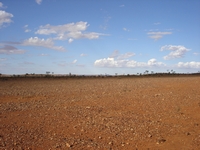Australia So Much to See


Henbury Meteorites Conservation Reserve

This panorama shows the extent of the overlapping craters, with the dark spur at the far side being the remnant of the division. Adjoining the main crater is the water crater which has a common wall with the edge of the crater on the right hand side of the picture.
A smaller crater with vegetation in the central depression.
Henbury Meteorites Conservation Reserve contains twelve craters which were formed when meteor fragments hit the earth's surface around
4,700 years ago. The craters range from seven to 180 metres in diameter and up to fifteen metres deep to six metres wide and
only a few centimetres deep. The smaller ones of these are now barely visible due to the effects of erosion. The largest
crater has been formed by two fragments, so is really two overlapping craters. Two spurs of dark rock on opposite outer edges
mark the division which has been eroded away. The scattered fragments of the Henbury Meteorite are extremely heavy as they consist
mainly of the metals iron (90%) and nickel (8%). Over 500 kilograms of fragments have been recovered from the site, the largest being
44 kilograms. Few specimens now remain in the area.
There is a total of thirteen kilometres of dirt road to
the craters after leaving the Stuart Highway; condition varies seasonally. We included this in a trip from Alice Springs without
the caravan, although had we been travelling further in this direction we would have taken our caravan in with no problems.
Looking across a cattle station on the way to Henbury. This harsh, dry and stony land is typical of stations we passed in the
area.
A creek runs into the water crater when it rains, and soil that has accumulated forms a base for Whitewood trees and grasses. These form a shelter and food source for animals such as euros and birds. Dingoes come to hunt these visitors to the crater.
There are 26 impact craters listed on Wikipedia. Some are in very remote regions. See the full list of craters and their
locations at:
Wikipedia list of impact craters in Australia
South of Alice Springs 2008. We visit Henbury Meteorite Craters Conservation Reserve.




To the right the broken line of the wall between these two overlapping craters can be seen jutting out near where the photo has been
taken from, and the remnant at the opposite side of the crater.
Copyright (C) 2013 AustraliaSoMuchtoSee.com. All rights reserved






